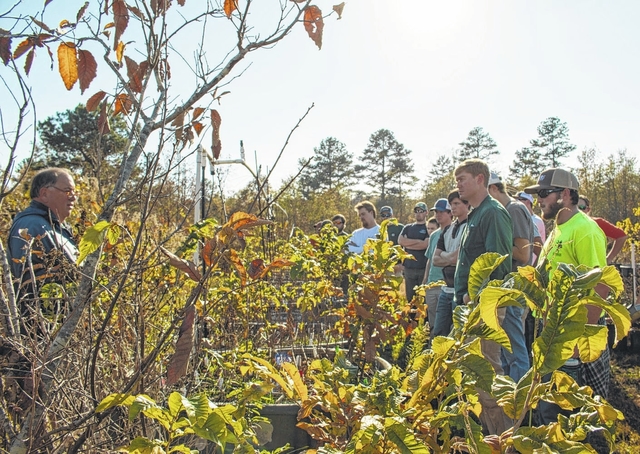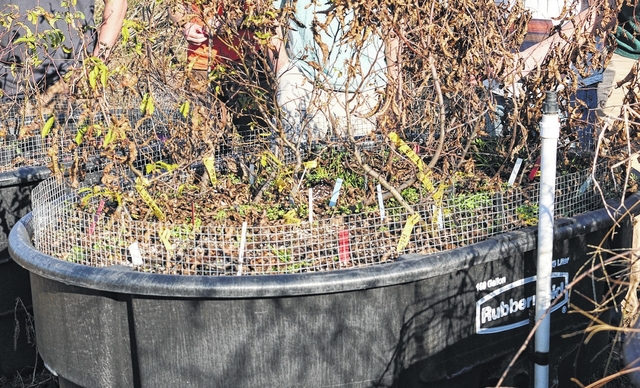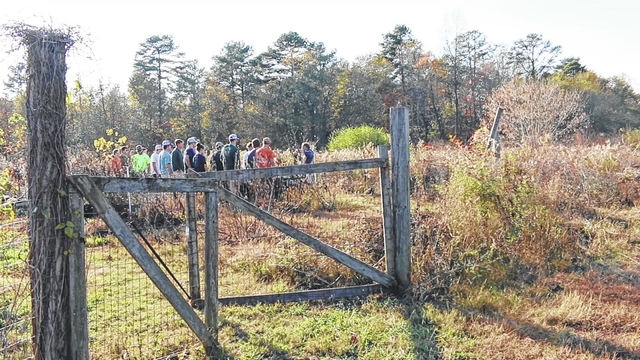SENECA — Clemson University graduate instructor Adam Coates and a boisterous class of forestry students recently visited a sprawling Upstate farm to learn about the latest scientific findings on the restoration of the American chestnut in southern climes.
Led by Dr. Joe James of Chestnut Return Farm in Oconee County, Coates and his students tromped from place to place on well-trodden trails, stopping at several experimental sites to listen to James discuss his research, which is performed in conjunction with several scientists at Clemson. When James told the tragic tale of the demise of billions of chestnut trees, the students grew less rambunctious and more pensive.
“I’m often asked why I feel so passionate about the American chestnut tree,” said James, who has been working with Clemson professor Steven Jeffers, an Extension specialist in plant pathology, since the early 2000s. “There are obvious reasons, of course. The trees were huge, beautiful and extremely useful to those who lived within their range. But to me, the main reason is that the demise of the chestnut left a big hole in our ecological food chain. Just about every animal ate chestnuts, including humans. I can’t overestimate the damage caused by the loss of this invaluable food source.”
At the beginning of the 20th century, a fungus-like organism that became known as chestnut blight began an airborne march from Maine to Florida, killing an estimated four billion chestnut trees. By the 1940s, the final remnants of the towering behemoths collapsed beneath the weight of the assault. In the decades since, the blight has become widely studied and discussed.
However, something far less publicized but no less lethal occurred half a century before the blight arrived in the United States from Asia. In the mid-1800s, most of the American chestnut trees in the Piedmont region of the Carolinas succumbed to a form of severe root rot brought on by Phytophthora cinnamomi, a water mold that is actually a form of red algae that kills or damages many trees and plants, including the American chestnut.
“Here on this farm, we are dedicated to Phytophthora screening and selection of trees that are resistant to Phytophthora cinnamomi by breeding varieties of a few surviving American chestnuts with Chinese chestnuts, which are inferior to our trees except that they are resistant to both root rot and the blight,” James told the students as he loomed over a row of tubs containing test plants of various ages and varieties. “It’s a terrible disease that thrives in relatively warm climates all over the United States – from Pennsylvania on south. So even if we breed trees that are resistant to blight, it’s going to be impossible to bring the chestnuts back to their full range if they aren’t also resistant to the root rot.”
The American Chestnut Foundation, in partnership with a variety of scientific institutions that includes Clemson University, has conducted decades-long research aimed at restoring the majestic trees in the wild. Despite massive efforts, the breeding of American-type chestnuts that are resistant to blight and root rot remains a work in progress. But it was James who first brought awareness of the dangers of root rot to the forefront. Beforehand, blight was considered the lone serious culprit.
“Few people involved in the restoration efforts had even heard of Phytophthora cinnamomi,” said James, a retired orthopedic surgeon. “And when I presented my data at a national meeting, it was met with disbelief. My colleagues even made good-natured jokes about my findings. It took about four years of repeatedly pounding on the door and presenting the data over and over before they finally began to realize it was a real problem that was comparable in its deadliness to the blight itself.”
Coates, who is a Ph.D candidate in the forestry and environmental conservation department in Clemson’s College of Agriculture, Forestry and Life Sciences, said the field trip to James’ farm – attended by 22 students in a course called Integrated Forest Pest Management – was one of the highlights of the fall semester.
“One of the biggest things we learned is just how important the American chestnut was to the historic landscape of the Piedmont and southern Appalachians,” Coates said. “And learning how widespread and dangerous Phytophthora cinnamomi is to the chestnut was an eye-opener for my students and me. We left Dr. James’ farm with a far better understanding of the amount of work that goes into any type of ecological restoration and particularly on this particular species that once held such importance.”
Jay Deason, an undergraduate from Greenville, said this was the first time he’d fully grasped how large a role root rot played in the destruction of the American chestnut in the warmer regions of the eastern U.S.
“Dr. Joe James has dedicated a great deal of time to cross-breeding American chestnuts with Chinese chestnuts in order to eradicate the chestnut blight and bring back viable trees,” Deason said. “I learned that there is another problem affecting American chestnuts that has caused just as much, if not more, damage to chestnuts than the blight.”
Austin Harris, a graduate student from Irmo, was impressed by James’ persistence and dedication.
“Dr. Joe James has a passion that is extremely rare to most individuals,” Harris said. “He wants to bring back the American chestnut through hybridization with the Chinese chestnut. And over 15 years, he’s made huge progress.”
Adam Forbes, an undergraduate from Manning, hopes that the research being conducted at Chestnut Return Farm will eventually lead to an “amazing breakthrough.”
“I learned that selecting for a resistant chestnut tree takes a lot more work than I would have expected,” Forbes said. “It’s amazing how much time and effort is being put into the crossbreeding and gene selection.”
Lane Whitmire, an undergraduate student from Brevard, fondly remembers his grandparents – who were alive before the great trees fell to ruin – telling him many stories about the grandeur of the American chestnut.
“I was interested in the American chestnut before even coming here,” Whitmire said. “And I’ve heard a lot of stories from my grandparents about actually standing beneath these magnificent trees. My grandpa told me that his dad, my great grandfather, would take big flour sacks, walk out in the woods and just rake up chestnuts by the thousands, stuffing the sacks to the bursting point. Hopefully, one day it will be like this again.”
“We’re so close. We’ve got the science at our fingertips,” James said. “One day, I’d like to have a picnic under an American chestnut tree. Time is my enemy, and it’ll be a close call. But what was once just a dream is creeping closer and closer to reality. I’ve been frustrated at times, but I’ve never lost my confidence that we’ll succeed in the end.”



